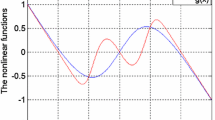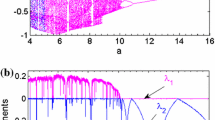Abstract
Finding and revealing new features and behaviors of simple chaotic systems have always been an important and attractive research topic. This paper aims to introduce a new 3D autonomous jerk chaotic system and explore its rich dynamical behaviors including period-doubling bifurcation and reverse period-doubling bifurcation routes to chaos, crisis and internal crisis, multiple symmetric coexisting attractors, and antimonotonicity. Especially, the phenomena of asymmetric bistability (e.g., coexistence of a point attractor and chaotic attractor or coexistence of a point attractor and period-5 limit cycle), tristability (e.g., coexistence of a point attractor and a pair of symmetric chaotic or periodic attractors), and coexisting bubbles are found, which have been rarely reported before. By using standard nonlinear analysis methods such as bifurcation diagrams, the largest Lyapunov exponent, phase portraits, Poincaré sections, 0–1 test chart and the basin of attraction for an attractor, and the complex dynamical behaviors of the system are investigated in detail. Furthermore, a corresponding hardware electronic circuit is designed to verify the numerical simulations.
Access this article
We’re sorry, something doesn't seem to be working properly.
Please try refreshing the page. If that doesn't work, please contact support so we can address the problem.















Similar content being viewed by others
References
J.C. Sprott, Some simple chaotic flows [J]. Phys Rev E 50(2), R647 (1994). https://doi.org/10.1103/physreve.50.r647
K.H. Sun, J.C. Sprott, A simple jerk system with piecewise exponential nonlinearity [J]. Int J Nonlin Sci Num 10(11–12), 1443–1450 (2009). https://doi.org/10.1515/IJNSNS.2009.10.11-12.1443
K. Rajagopal, V.T. Pham, F.R. Tahir, A. Akgul, H.R. Abdolmohammadi, S. Jafari, A chaotic jerk system with non-hyperbolic equilibrium: dynamics, effect of time delay and circuit realization [J]. Pramana 90(4), 52–58 (2018). https://doi.org/10.1007/s12043-018-1545-x
C. Wang, H. Xia, L. Zhou, A memristive hyperchaotic multiscroll jerk system with controllable scroll numbers [J]. Int J Bifurcat Chaos 27(6), 1750091 (2017). https://doi.org/10.1142/S0218127417500912
A.R. Elsonbaty, A.M.A. El-Sayed, Further nonlinear dynamical analysis of simple jerk system with multiple attractors [J]. Nonlinear Dynam 87(2), 1169–1186 (2017). https://doi.org/10.1007/s11071-016-3108-3
J. Ma, X. Wu, R. Chu, et al., Selection of multi-scroll attractors in jerk circuits and their verification using Pspice [J]. Nonlinear Dynam 76(4), 1951–1962 (2014). https://doi.org/10.1007/s11071-014-1260-1
X. Xia, Y. Zeng, Z. Li, Coexisting multiscroll hyperchaotic attractors generated from a novel memristive jerk system [J]. Pramana 91(6), 82–14 (2018). https://doi.org/10.1007/s12043-018-1657-3
S. Fang, Z. Li, X. Zhang, Y. Li, Hidden extreme multistability in a novel no-equilibrium fractional-order chaotic system and its synchronization control [J]. Braz J Phys 49, 1–13 (2019). https://doi.org/10.1007/s13538-019-00705-1
K. Rajagopal, S. Jafari, A. Akgul, A. Karthikeyan, Modified jerk system with self-exciting and hidden flows and the effect of time delays on existence of multi-stability [J]. Nonlinear Dyn 93, 1087–1108 (2018). https://doi.org/10.1007/s11071-018-4247-5
T.V. Kamdoum, K.S. Takougang, K.G. Fautso, et al., Coexistence of attractors in autonomous Van der Pol-Duffing jerk oscillator: analysis, chaos control and synchronisation in its fractional-order form [J]. Pramana 91(1), 12–11 (2018). https://doi.org/10.1007/s12043-018-1586-1
W. Zhen, A. Akgul, V.T. Pham, et al., Chaos-based application of a novel no-equilibrium chaotic system with coexisting attractors [J]. Nonlinear Dyn 89(3), 1877–1887 (2017). https://doi.org/10.1007/s11071-017-3558-2
S. Vaidyanathan, A. Akgul, S. Kaçar, U. Çavuşoğlu, A new 4-D chaotic hyperjerk system, its synchronization, circuit design and applications in RNG, image encryption and chaos-based steganography [J]. Eur Phys J Plus 133(2), 46–18 (2018). https://doi.org/10.1140/epjp/i2018-11872-8
K. Rajagopal, A. Akgul, S. Jafari, et al., Chaotic chameleon: dynamic analyses, circuit implementation, FPGA design and fractional-order form with basic analyses [J]. Chaos, Solitons Fractals 103, 476–487 (2017). https://doi.org/10.1016/j.chaos.2017.07.007
H.P. Ren, C. Bai, K. Tian, et al., Dynamics of delay induced composite multi-scroll attractor and its application in encryption [J]. Int J Nonlin Mech 94, 334–342 (2017). https://doi.org/10.1016/j.ijnonlinmec.2017.04.014
Ü. Çavuşoğlu, S. Panahi, A. Akgül, S. Jafari, S. Kaçar, A new chaotic system with hidden attractor and its engineering applications: analog circuit realization and image encryption [J]. Analog Integr Circ S 2019, 98(1):85-99. https://doi.org/10.1007/s10470-018-1252-z
J. Sun, Y. Shen, Q. Yin, et al., Compound synchronization of four memristor chaotic oscillator systems and secure communication [J]. Chaos 23(1), 013140 (2013). https://doi.org/10.1063/1.4794794
T.C. Lin, F.Y. Huang, Z. Du, et al., Synchronization of fuzzy modeling chaotic time delay memristor-based Chua’s circuits with application to secure communication [J]. Int J Fuzzy Syst 17(2), 206–214 (2015). https://doi.org/10.1007/s40815-015-0024-5
S.T. Pan, C.C. Lai, Identification of chaotic systems by neural network with hybrid learning algorithm [J]. Chaos, Solitons Fractals 37(1), 233–244 (2008). https://doi.org/10.1016/j.chaos.2006.08.037
S.P. Adhikari, H. Kim, R.K. Budhathoki, et al., A circuit-based learning architecture for multilayer neural networks with memristor bridge synapses [J]. IEEE Trans Circ Syst I, Reg Pap 62(1), 215–223 (2015). https://doi.org/10.1109/TCSI.2014.2359717
E.K. Lee, H.S. Pang, J.D. Park, et al., Bistability and chaos in an injection-locked semiconductor laser [J]. Phys Rev A 47(1), 736–739 (1993). https://doi.org/10.1103/PhysRevA.47.736
C. Li, J.C. Sprott, W. Thio, Bistability in a hyperchaotic system with a line equilibrium [J]. J Exp Theor Phys 118(3), 494–500 (2014). https://doi.org/10.1134/S1063776114030121
J.C. Sprott, S. Jafari, V.T. Pham, et al., A chaotic system with a single unstable node [J]. Phys Lett A 379(36), 2030–2036 (2015). https://doi.org/10.1016/j.physleta.2015.06.039
J.R.M. Pone, V.K. Tamba, G.H. Kom, et al., Period-doubling route to chaos, bistability and antimononicity in a jerk circuit with quintic nonlinearity [J]. International Journal of Dynamics and Control 7(1), 1–22 (2019). https://doi.org/10.1007/s40435-018-0431-1
S. Lynch, Multistability, bistability and chaos control [J]. Nonlinear Anal-Theor 47(7), 4501–4512 (2001). https://doi.org/10.1016/S0362-546X(01)00563-6
X.Z. He, K. Li, C. Wang, Time-varying economic dominance in financial markets: a bistable dynamics approach. [J]. Chaos 28(5), 055903 (2018). https://doi.org/10.1063/1.5021141
S.P. Dawson, C. Grebogi, J.A. Yorke, et al., Antimonotonicity: inevitable reversals of period-doubling cascades [J]. Phys Lett A 162(3), 249–254 (1992). https://doi.org/10.1016/0375-9601(92)90442-o
J. Kengne, V.R.F. Signing, J.C. Chedjou, et al., Nonlinear behavior of a novel chaotic jerk system: antimonotonicity, crises, and multiple coexisting attractors [J]. Int J Dyn Control 6(11), 1–18 (2017). https://doi.org/10.1007/s40435-017-0318-6
J. Kengne, S.M. Njikam, V.R.F. Signing, A plethora of coexisting strange attractors in a simple jerk system with hyperbolic tangent nonlinearity [J]. Chaos, Solitons Fractals 106, 201–213 (2018). https://doi.org/10.1016/j.chaos.2017.11.027
L. Zhou, C. Wang, X. Zhang, et al., Various attractors, coexisting attractors and antimonotonicity in a simple fourth-order memristive twin-T oscillator [J]. Int J Bifurcation Chaos 28(04), 1850050 (2018). https://doi.org/10.1142/S0218127418500505
S. Zhang, Y. Zeng, A simple jerk-like system without equilibrium: asymmetric coexisting hidden attractors, bursting oscillation and double full Feigenbaum remerging trees [J]. Chaos, Solitons Fractals 120, 25–40 (2019). https://doi.org/10.1016/j.chaos.2018.12.036
H.P.W. Gottlieb, Question 38. What is the simplest jerk function that gives chaos [J]. Am J Phys 64, 525–525 (1996). https://doi.org/10.1119/1.18276
G.A. Gottwald, I. Melbourne, On the validity of the 0-1 test for chaos [J]. Nonlinearity 22(6), 1367 (2009). https://doi.org/10.1088/0951-7715/22/6/006
A. Wolf, J.B. Swift, H.L. Swinney, et al., Determining Lyapunov exponents from a time series [J]. Physica D 16(3), 285–317 (1985). https://doi.org/10.1016/0167-2789(85)90011-9
G. Manai, F. Delogu, M. Rustici, Onset of chaotic dynamics in a ball mill: attractors merging and crisis induced intermittency [J]. Chaos 12(3), 601–609 (2002). https://doi.org/10.1063/1.1484016
C. Li, J.C. Sprott, Multistability in the Lorenz system: a broken butterfly [J]. Int J Bifurcation Chaos 24(10), 1450131 (2014). https://doi.org/10.1142/S0218127414501314
L. Kocarev, K.S. Halle, K. Eckert, et al., Experimental observation of antimonotonicity in Chua’s circuit [J]. Int J Bifurcation Chaos 3, 1051–1055 (1993). https://doi.org/10.1142/s0218127493000878
B. Bocheng, X. Li, W. Ning, et al., Third-order RLCM-four-elements-based chaotic circuit and its coexisting bubbles [J]. AEU Int J Electron Commun 94, 26–35 (2018). https://doi.org/10.1016/j.aeue.2018.06.042
S. Zhang, Y. Zeng, Z. Li, et al., Hidden extreme multistability, antimonotonicity and offset boosting control in a novel fractional-order hyperchaotic system without equilibrium [J]. Int J Bifurcation Chaos 28(13), 1850167 (2018). https://doi.org/10.1142/S0218127418501675
K. Srinivasan, K. Thamilmaran, A. Venkatesan, Effect of nonsinusoidal periodic forces in Duffing oscillator: numerical and analog simulation studies [J]. Chaos, Solitons Fractals 40(1), 319–330 (2009). https://doi.org/10.1016/j.chaos.2007.07.090
I.M. Kyprianidis, I.N. Stouboulos, P. Haralabidis, et al., Antimonotonicity and chaotic dynamics in a fourth-order autonomous nonlinear electric circuit. [J]. Int J Bifurcation Chaos 10(08), 1903–1915 (2000). https://doi.org/10.1142/S0218127400001171
Funding
The work was supported by the National Natural Science Foundations of China under Grant No. 61471310.
Author information
Authors and Affiliations
Corresponding author
Additional information
Publisher’s Note
Springer Nature remains neutral with regard to jurisdictional claims in published maps and institutional affiliations.
Rights and permissions
About this article
Cite this article
Li, Y., Zeng, Y. & Zeng, J. A Unique Jerk System with Abundant Dynamics: Symmetric or Asymmetric Bistability, Tristability, and Coexisting Bubbles. Braz J Phys 50, 153–163 (2020). https://doi.org/10.1007/s13538-019-00731-z
Received:
Published:
Issue Date:
DOI: https://doi.org/10.1007/s13538-019-00731-z




